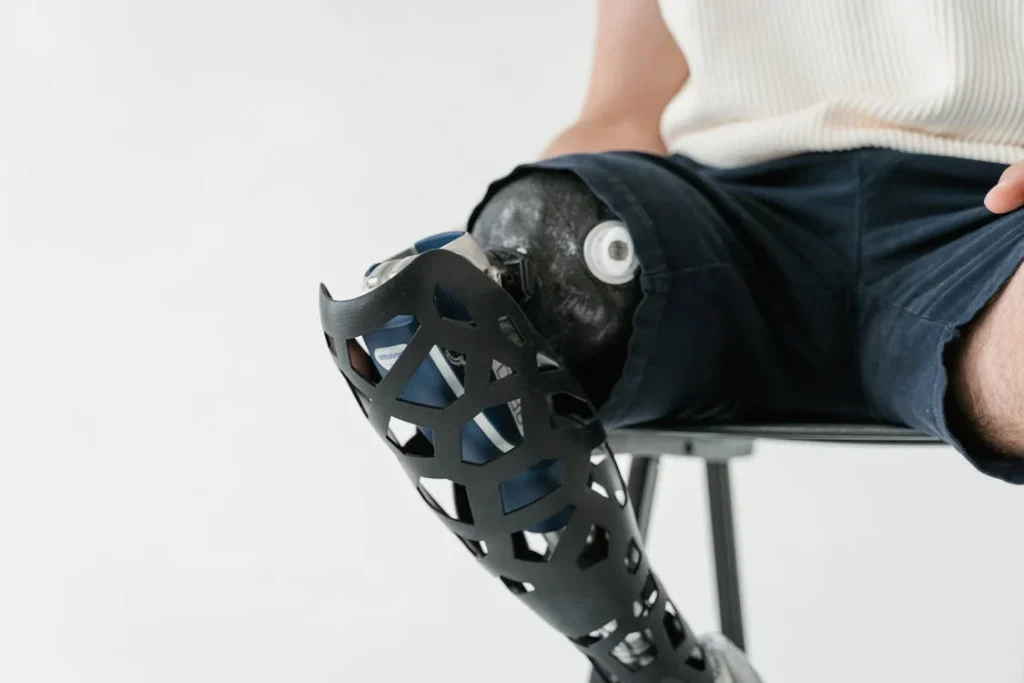Back pain and hip pain are often seen as unrelated to prosthetics. People usually blame age, posture, or old injuries. But for many amputees, the real cause is something much simpler—poor socket alignment. When the prosthetic socket isn’t aligned correctly with the body, even by a few degrees, it can throw off the entire balance of movement. That’s when the pain starts creeping in, often without any warning.
This is more common than most people think. A socket that’s even slightly tilted or misaligned can force the wearer to walk differently, shift weight unevenly, or lean to one side. Over time, these small changes lead to strain on the lower back, hips, and even the shoulders. Most amputees don’t realize this is happening until the discomfort becomes a part of everyday life. And sadly, many learn to live with the pain, not knowing that a better socket fit and proper alignment could change everything.
At Robobionics, we’ve seen how powerful a well-aligned socket can be. It doesn’t just improve walking—it restores comfort, posture, and confidence. We’ve worked with people who thought they needed surgery or medication for back issues, only to find relief after a simple adjustment to their socket.
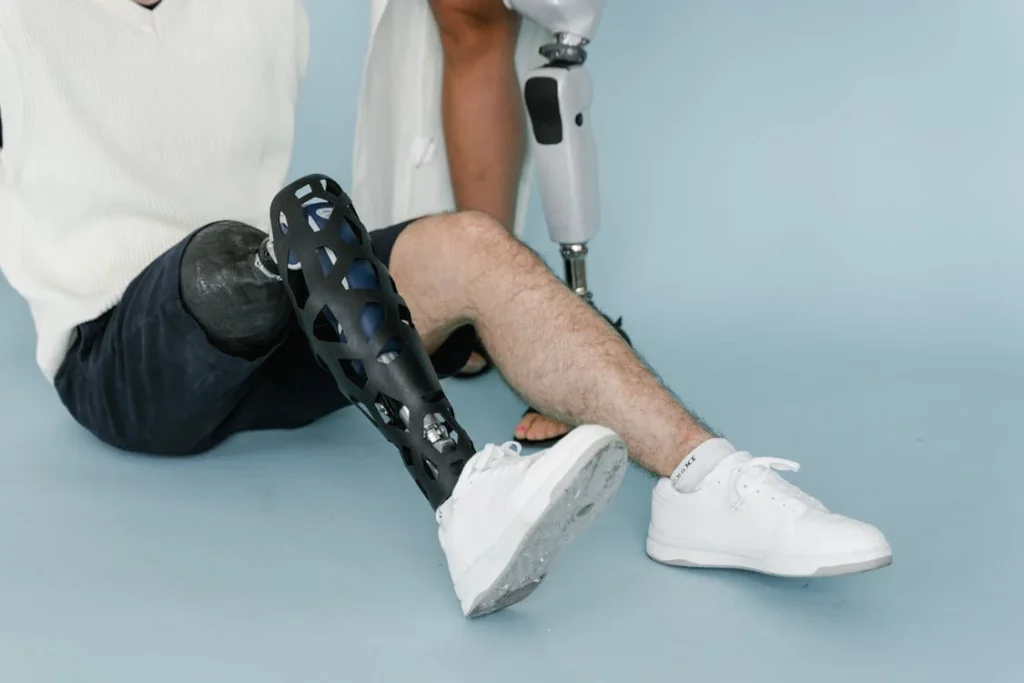
How Socket Alignment Affects the Entire Body
Understanding the Chain Reaction of Misalignment
The human body is designed to move as one connected unit. Every step, every twist, every motion we make involves a chain of movements that starts at the ground and travels all the way up.
When one link in that chain is off, the rest of the body has to compensate. That’s exactly what happens when a prosthetic socket is not aligned properly.
A socket that tilts too far inward or outward can shift how your foot lands on the ground. This changes the way your knee moves. The knee then pushes the hip into an unnatural position.
And before you know it, your lower back starts to bear weight unevenly. It’s a subtle chain reaction, but it builds up fast.
For example, if a socket is slightly rotated, it can cause the pelvis to twist during walking. That twist might be small at first, but over time, it wears down the muscles around the spine.
This leads to tightness, soreness, and eventually chronic back pain. In the hips, the same rotation can pull one side more than the other, causing inflammation or stiffness in the joints.
What makes it worse is that many people don’t notice these changes right away. They adapt to the new movement without thinking, especially if they’re focused on learning to walk again or just trying to get through daily life. By the time the pain shows up, the bad habits have already formed, and realignment becomes harder.
The Difference Between Static and Dynamic Alignment
Socket alignment is not just about how your leg looks when you’re standing still. That’s known as static alignment. While static alignment is important, it’s only half the picture.
The real story begins when you move—when you walk, turn, sit, or climb stairs. That’s dynamic alignment, and it’s where most alignment problems hide.
You might have a socket that feels fine when you’re sitting or standing. But as soon as you start walking, something feels off. Maybe your foot hits the ground harder on one side.
Maybe you feel like you’re leaning, or like you’re always catching yourself before falling. These are signs that your socket isn’t aligned for your movement.
Dynamic alignment requires us to understand how the body behaves in motion. At Robobionics, we use video gait analysis and pressure mapping to study exactly how a person walks. This helps us catch even the smallest alignment issues—things that can’t be seen in a static fitting.
We’ve seen people walk with a slight hitch in their step because their socket sits too far forward. That small hitch forces their lower back to absorb extra force with every step.
Over time, that creates compression in the spine, which leads to chronic lower back pain. Fixing the alignment often brings relief in just days, sometimes even hours.
Why Every Body Is Different
Alignment is not a one-size-fits-all situation. What works for one person might cause pain for another. That’s because every body is shaped differently.
Limb length, muscle tone, pelvic tilt, spinal curves—these things change how a prosthetic interacts with the rest of the body.
Some people have naturally wide hips. Others have a spine that curves slightly to one side. These features affect how the body balances.
A socket that’s perfectly aligned on paper might still cause issues if it doesn’t match the user’s unique body shape.
That’s why proper alignment must always begin with an in-depth evaluation of the person, not just the limb. We don’t just measure angles—we watch how people move, how they react, and how their body carries weight. We ask questions about their pain, their habits, their daily routines. All of this gives us the full picture.
What we’ve found over the years is that most alignment issues aren’t just technical problems. They’re personal ones. They require a human approach, not just a mechanical one. That’s where true comfort comes from.
The Hidden Pain of Overcompensation
One of the biggest dangers of poor socket alignment is the way the body learns to overcompensate. When something feels off, your brain tells your body to adjust.
Maybe you lean slightly to one side. Maybe you put more weight on your good leg. Maybe you twist your upper body to counterbalance the lower half.
These small adjustments might help in the short term, but over time, they create new problems. Muscles on one side become tight while others weaken.
The pelvis gets pulled out of its natural position. The spine starts curving in ways it shouldn’t. Eventually, you’re not just dealing with socket discomfort—you’re dealing with full-body strain.
Back pain caused by overcompensation often feels like a dull, constant ache. It might get worse when you stand too long, sit for too long, or walk a certain distance.
You may also notice hip pain on the opposite side of your amputation. That’s because your body is doing too much to protect the side that feels unstable.
In many cases, people live with this pain for years, thinking it’s just part of life with a prosthetic. But the real cause might be as simple as adjusting the socket angle or repositioning the foot.
That’s the power of alignment—it can ease pain without pills, without therapy, and without surgery.
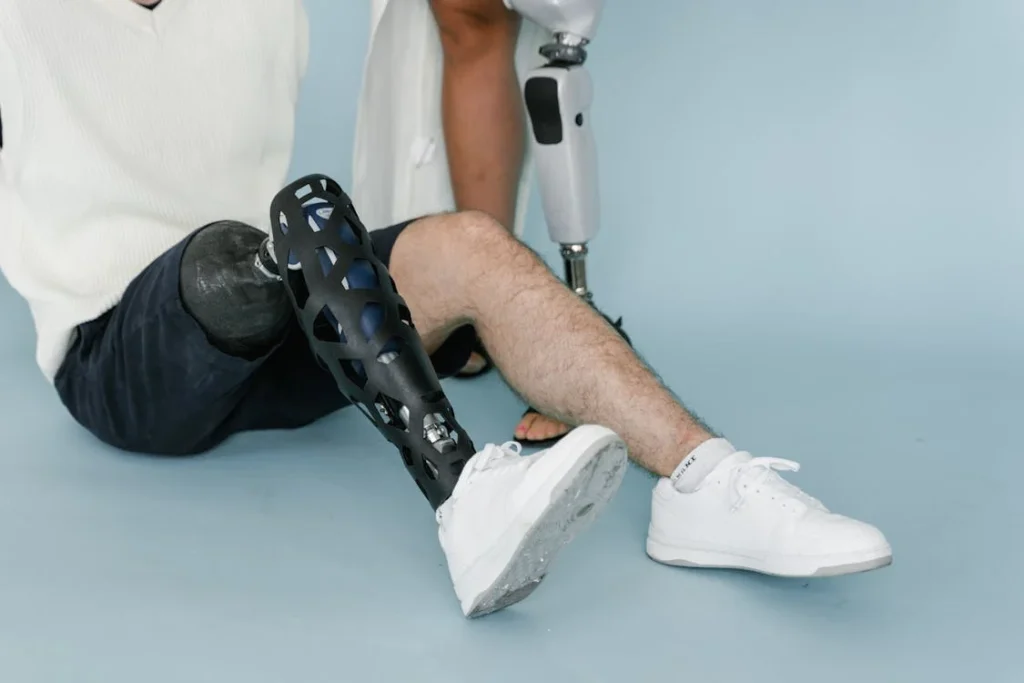
How Proper Socket Alignment Prevents Pain and Supports Natural Movement
Creating a Straight and Balanced Foundation
The socket is the foundation of every step an amputee takes. If that foundation is tilted, uneven, or rotated, everything built on top of it—hip, spine, posture, gait—gets thrown out of balance.
Proper alignment means that the body can move in a straight, natural line, just like it was meant to before the amputation.
At Robobionics, we always begin by aiming for what we call a “neutral foundation.” That doesn’t mean perfectly straight in a textbook sense—it means perfectly balanced for that person’s unique body.
This means the socket should allow the foot to strike the ground flat and stable. The knee should bend naturally.
The hip should glide smoothly without having to swing or rotate unnaturally. And the spine should stay aligned without needing to bend, tilt, or compensate.
When we get this foundation right, the benefits are clear and immediate. The body stops fighting itself. Muscles stop overworking.
Weight spreads evenly across both sides of the pelvis. And best of all, the user feels like walking is easier—because it is.
They don’t have to think about every step or brace against pain. Their movement becomes more fluid, more confident, and more natural.
Rebalancing the Hips: A Key to Spinal Health
One of the first places poor socket alignment shows up is in the hips. When the socket is even slightly off, it changes the angle of the pelvis.
A rotated socket can cause one hip to drop or rise unnaturally, throwing off balance with every step. This might be subtle in the beginning, but over time, the spine starts to respond.
The muscles along the spine begin to tighten on one side. The back tries to hold the body upright, even though the hips are misaligned.
That’s when back pain starts creeping in—usually as a dull ache or stiffness after walking. If the problem continues, it can lead to muscle spasms, nerve pinching, or even curvature of the spine.
We’ve worked with many people who were unaware that their back pain was linked to their socket. They thought it was old age or bad posture.
But once we corrected the pelvic alignment through the socket, they experienced relief within days. Some even regained range of motion they hadn’t had in years.
It’s not magic—it’s biomechanics. When the hips are aligned, the spine can relax. When the spine relaxes, the whole body moves more freely. And when movement becomes easy again, pain starts to fade.
Restoring Symmetry in Every Step
Humans are built to move symmetrically. Left foot, right foot. Equal stride. Balanced weight. This rhythm is what keeps the joints and muscles working smoothly.
But when socket alignment is off, that rhythm is lost. One step might be shorter than the other. One leg might land harder. The torso may twist slightly to one side. These small disruptions add up quickly.
The body does everything it can to keep you upright. So it compensates. The stronger side carries more weight. The other side tries to keep up.
But this constant imbalance creates extra stress on the hips and lower back. It’s like driving a car with one flat tire—you can still move forward, but the ride is rough, and the damage adds up.
By aligning the socket correctly, we bring back that natural symmetry. The steps even out. The hips move in a more stable arc. The back stops twisting. And for the user, walking feels smoother—not forced or exhausting.
One of the most satisfying moments in our clinic is when someone tries a realigned socket and suddenly walks in a straight line without effort. Their face lights up.
They don’t always know why it feels better—they just know it does. That’s the moment we know we’ve restored not just motion, but ease.
Improving Energy Transfer and Reducing Fatigue
Poor alignment doesn’t just cause pain—it also drains energy. Every step takes more effort when the body has to adjust for a socket that doesn’t support movement properly.
Over time, that extra effort leads to fatigue, both physical and mental. People find themselves slowing down, avoiding long walks, or choosing rest over activity—not because they’re tired, but because their body is working too hard to do simple things.
Proper alignment allows energy to move through the body efficiently. The push-off from the foot transfers smoothly to the knee, then to the hip, then to the spine.
There are no leaks, no losses, no sudden jerks or stops. This is how the body was designed to work. When the socket supports that flow, every step takes less effort. That means more endurance, longer walks, better mood, and more freedom.
We’ve had users tell us they went from needing multiple rest breaks throughout the day to walking for hours without pain or fatigue—just by realigning the socket.
It’s not about building strength or pushing harder. It’s about working smarter—letting the body move the way it was always meant to.
The Emotional Relief of Pain-Free Movement
There’s one more piece that doesn’t get talked about enough: the emotional weight of daily pain. Living with back or hip pain wears down more than just the body.
It affects mood, sleep, confidence, and motivation. It turns simple tasks into burdens. And when the cause is hidden—like a poorly aligned socket—it’s even more frustrating.
Many amputees start to feel like the pain is their fault. They think they’re not walking correctly, or that their body is just broken. But often, the problem isn’t with them—it’s with the tool they’ve been given to walk.
When alignment is fixed, and pain starts to fade, people begin to believe in their bodies again. They walk taller, not just physically, but emotionally.
They become more active, more independent, more engaged in life. We’ve seen this transformation again and again. It never gets old.
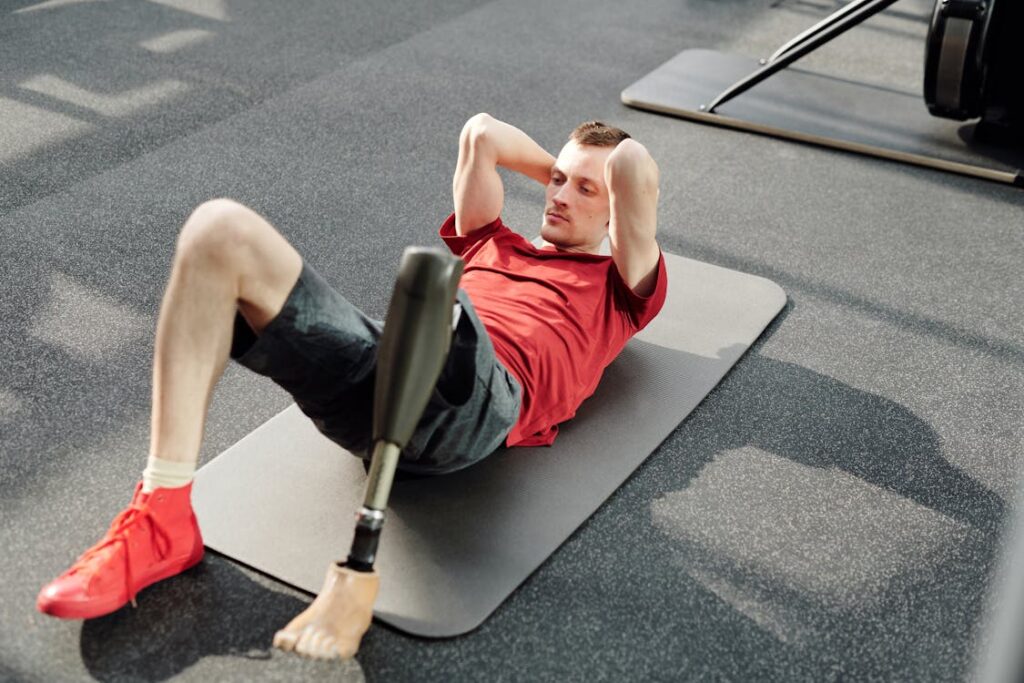
The Process of Achieving Perfect Socket Alignment
It Starts with Observation, Not Assumption
One of the most common mistakes in prosthetics is rushing the alignment process. Too often, practitioners focus on measurements, charts, or pre-set alignment guides before truly watching how a person moves.
At Robobionics, our approach begins differently—we observe first. We let the user walk, move, sit, and stand while we closely study their posture, motion patterns, and signs of imbalance.
This observation gives us a real-world view of how the current alignment affects the entire body. We look at the shoulders—are they even? We watch the hips—do they sway or rotate unnaturally? We examine the gait—does one foot strike harder than the other? Even subtle things like head tilt or arm swing tell us a lot about hidden compensations.
We also ask the user to describe their pain in detail. Where does it start? When does it get worse? What makes it better? These answers help us identify how the socket is influencing spinal and pelvic alignment. It’s not about guesswork. It’s about understanding the full picture before making any changes.
Alignment Adjustments: A Game of Millimeters
Once we know what needs to change, we begin fine-tuning the socket’s position. Alignment is rarely about big changes—it’s usually a matter of small, precise movements.
Sometimes shifting the socket just a few millimeters backward, or rotating it by a couple of degrees, can completely transform how the body feels during movement.
We work in stages, making one adjustment at a time, then testing the results. After each change, the user walks again.
We ask how it feels. We watch for changes in gait and posture. We look for signs of relaxation in the back, or improved balance at the hips.
In many cases, we use in-clinic tools like adjustable alignment jigs and laser guides to make sure every change is exact.
These tools help us position the socket in perfect relation to the rest of the prosthetic components, such as the foot and knee. They also let us test how changes in foot angle or heel height affect the body’s alignment.
The user is always part of this process. We believe alignment isn’t just technical—it’s personal. What feels “correct” on paper may not feel right in real life.
That’s why we listen closely to every comment and cue from the person wearing the socket. Their comfort is the ultimate goal.
Integrating Dynamic Alignment Techniques
After static adjustments are complete, we move into dynamic alignment—the part that focuses on how the body behaves while in motion.
This is where real breakthroughs happen. People often don’t realize just how much the body shifts between standing and walking until they see it on video or feel the difference after an alignment tweak.
We use gait analysis software and pressure mapping tools to track how force moves through the limb during each phase of walking.
This shows us whether one side is working harder, or if certain areas are bearing too much load. For example, if the foot is landing slightly outward with each step, it may be causing a twist in the pelvis.
By adjusting the socket’s rotation, we can bring the foot back into alignment and relieve that twist.
Sometimes, we ask users to walk across different surfaces, including ramps or uneven ground, to see how alignment holds up in real-world conditions.
A socket that feels fine on a smooth floor might not perform well outdoors. That’s why dynamic testing is essential—it exposes weak spots before they become problems.
We’ve had users tell us that a simple adjustment during dynamic alignment made them feel like they were “walking on air.” It’s a reminder that even small changes can unlock massive improvements in comfort and function.
Custom Alignment for Every Lifestyle
Different people move differently. A retired teacher who walks indoors most of the day will need a different alignment than a farmer who spends hours standing, lifting, and moving on rough terrain.
That’s why we customize alignment not just to the body, but to the lifestyle.
If someone enjoys walking long distances, we focus on energy efficiency and stride symmetry. If their job involves a lot of standing, we pay special attention to weight distribution and spinal posture.
If they do sports or high-impact activities, we build in more responsive alignment that supports fast movement without strain.
This tailored approach ensures that the socket supports the person—not just when they’re being evaluated, but during their actual life. Too often, sockets are fitted in perfect clinic conditions but fail under daily use.
At Robobionics, we take the time to understand what your real life looks like—so your socket can meet those demands every single day.
Follow-Ups: The Missing Link in Long-Term Comfort
Alignment is not a one-time fix. The body changes. Muscles strengthen or weaken. Hips may tighten or loosen. Even small shifts in weight can affect alignment. That’s why follow-up appointments are not optional—they’re essential.
We schedule follow-ups within the first week after final alignment, then again after a month, and periodically after that.
During each visit, we check for signs of wear in the socket, shifts in posture, or changes in how the user walks. We also talk about any new pain or discomfort, and adjust the alignment if needed.
These small touchpoints keep the socket aligned with the body’s natural evolution. They help prevent back pain, hip strain, and movement fatigue from returning. More importantly,
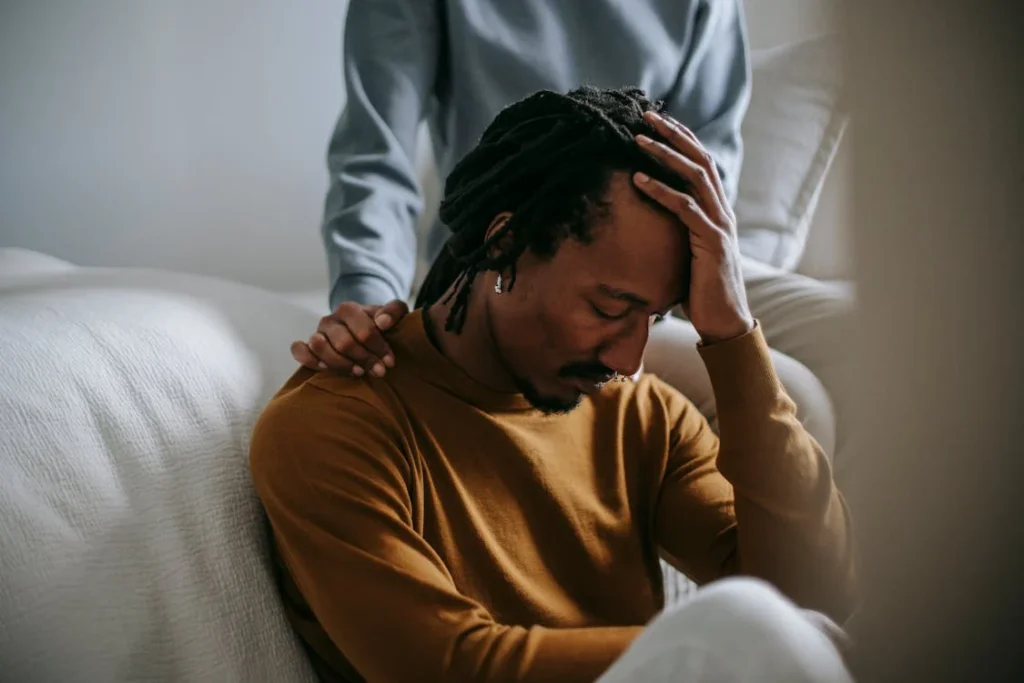
The Mental Burden of Misalignment—and the Confidence of Comfort
Pain Doesn’t Just Hurt the Body—It Affects the Mind
When people think of prosthetics, they usually think about mobility, strength, or balance. But what’s rarely discussed is the emotional toll of constant discomfort.
Misalignment doesn’t just create back or hip pain—it slowly chips away at a person’s mental well-being. When every step is a reminder that something’s wrong, it creates a cloud of frustration, stress, and anxiety that follows the person through every part of their day.
Many of the amputees we meet at Robobionics come to us carrying invisible emotional weight. Some feel helpless after visiting multiple clinics and trying different prosthetics, only to end up in more pain.
Others start doubting themselves. They begin to believe they’re too “hard to fit” or that pain is something they’ll just have to live with forever.
Over time, this mindset leads to withdrawal. People stop going out as much. They skip social events. They avoid walks or travel. Pain slowly takes away parts of their personality, not just their movement.
And all of this—every single bit of it—can sometimes be traced back to alignment.
The Shift That Happens When Pain Disappears
It’s difficult to describe the emotional reaction that comes when someone tries a properly aligned socket for the first time—especially after years of discomfort.
The first thing most people say isn’t about walking. It’s about how light they feel. As if a burden they didn’t even know they were carrying has been lifted.
We’ve seen people burst into tears after walking across the room without pain. We’ve seen smiles return to faces that had been tight with stress for months.
We’ve watched people go from cautious and guarded to confident and upright—just because their socket finally feels like an extension of their body, not something they have to fight against.
That emotional shift leads to real changes. People begin walking longer. They laugh more. They stop looking down with every step.
They start moving through the world without hesitation, and that opens doors to everything else: relationships, hobbies, independence, joy.
Misalignment and the Fear of Falling
One specific fear many amputees live with—often silently—is the fear of falling. When a socket is even slightly misaligned, it can create instability that’s hard to predict.
The body might feel fine one moment and unstable the next. This inconsistency builds anxiety, especially in public or unfamiliar spaces.
Many users become hyper-aware of every surface they walk on. They start scanning for slopes, wet floors, curbs.
Even standing in a crowd becomes stressful if they fear being bumped or knocked off balance. This fear becomes a constant mental background noise—an emotional tax on daily life.
But when alignment is corrected, that fear begins to fade. The body begins to trust the socket.
And when the body trusts the socket, the brain can focus on living again, not just surviving each step. It’s a silent victory, but a profound one.
Self-Image and the Way We Carry Ourselves
Body language isn’t just about communication—it’s also a reflection of how we feel. When someone is in pain or unsure about their movement, it shows in their posture.
They slump. They shuffle. Their eyes are down. But when alignment improves and the body starts to move freely, posture changes too.
People start standing straighter, walking taller, making eye contact again. They move through doors without hesitation. They stop avoiding mirrors. All of these are subtle, powerful signs that they feel better in their body—and about their body.
In fact, we’ve noticed that the benefits of proper alignment often go beyond pain relief. They improve how people feel about themselves.
That feeling of “I can do this” returns. That belief that their prosthesis is not a limitation, but a partner, begins to take root.
And that’s not just a technical success—it’s a human one.
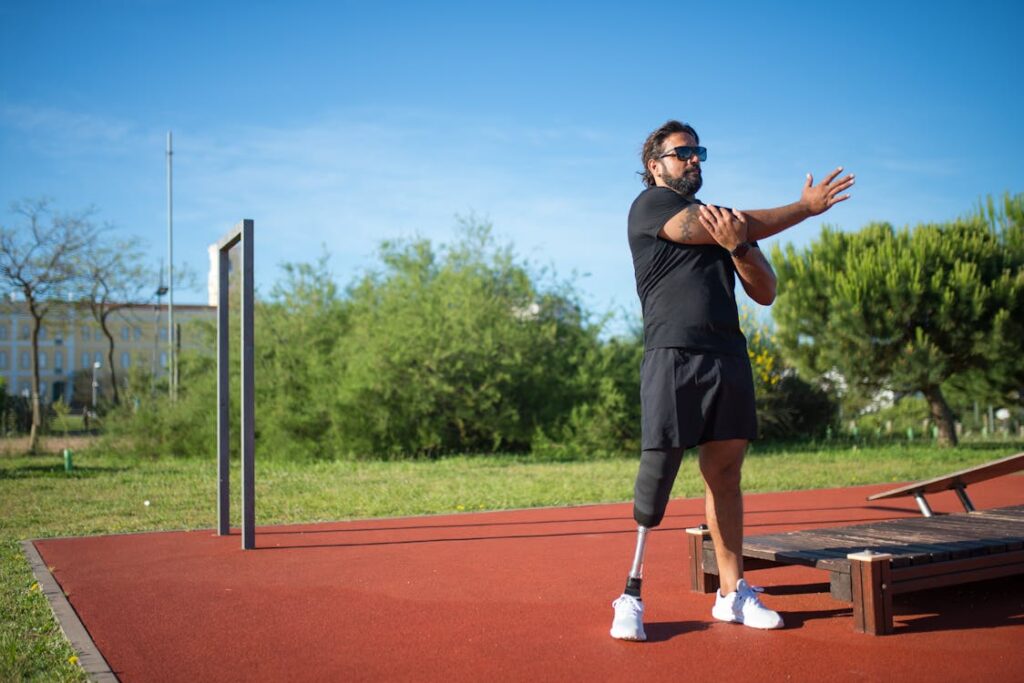
The Hidden Link Between Socket Alignment and Core Strength
Alignment Is Not Just About Legs—It Starts at the Core
When people think of walking, they usually focus on legs and feet. But true balance, stability, and posture all start from the center of the body—the core.
This group of muscles, which includes the abdominals, lower back, obliques, and pelvic floor, acts as the body’s anchor. It keeps you upright, steady, and responsive to every movement.
Now here’s the surprising part: socket alignment directly affects how those core muscles are used. When a socket is aligned correctly, the body can move naturally, and the core muscles activate in harmony.
But when a socket is misaligned—even slightly—the body adjusts. And the first thing that suffers is core engagement.
Let’s say the socket causes the limb to sit slightly behind the center of mass. This tiny change can force the upper body to lean forward to stay balanced.
That shift might seem harmless, but it causes the core muscles to work differently. Instead of stabilizing the spine, they begin bracing to prevent tipping.
Over time, this unnatural tension weakens the core—not because of lack of use, but because of incorrect use.
Weak Core, Weaker Foundation
When the core isn’t doing its job, everything else begins to work harder. The back takes more load. The hips become overactive.
The shoulders may begin to round forward. The result is a whole-body imbalance that slowly eats away at joint health and mobility.
We’ve seen users with chronic socket misalignment develop not just back pain, but also stiffness in the rib cage, shortness of breath during activity, and even digestive discomfort—all symptoms tied back to poor core activation.
Fixing socket alignment doesn’t just ease leg strain. It restores the body’s center of power. When the core re-engages properly, posture improves, movement becomes more fluid, and other muscle groups stop overcompensating.
It’s a ripple effect that spreads in all directions—and it all starts with getting the socket angle just right.
Long-Term Protection for Joints and Discs
Most people don’t think about the long-term effects of subtle misalignments. But over time, even small shifts in walking pattern can cause wear and tear in major joints. Hips, knees, and vertebral discs all suffer when the load isn’t balanced properly.
For example, when one side of the pelvis tilts slightly due to socket angle, it changes how the spine stacks. This small imbalance puts uneven pressure on the discs in the lower back, increasing the risk of degeneration or herniation over time.
Similarly, the hip joint on the non-amputated side often bears more load than it should, leading to early-onset arthritis in some cases.
Proper alignment reduces these risks dramatically. It spreads force evenly across the body. It keeps the joints working within their natural range.
It protects the spine from chronic bending or twisting. In short, it creates harmony in motion, which is the secret to lasting physical health.
We’ve seen older users who, after years of dealing with pain and stiffness, felt like they “got 10 years back” simply by correcting their alignment. It wasn’t magic. It was physics—and listening to their body’s signals.
Socket Fit vs. Socket Alignment: Knowing the Difference
There’s a crucial distinction to be made here: a socket can fit well but still be poorly aligned. Many amputees get stuck in this trap.
They feel the socket fits snugly and comfortably, so they assume everything is okay. But they still feel tired, imbalanced, or in pain.
Fit is about how the socket feels around the limb. Alignment is about how the socket interacts with the entire body.
You can have a comfortable fit that’s still positioned too far forward, backward, or tilted. That misposition affects every joint and muscle from the ankle to the neck.
That’s why we always evaluate both. We don’t stop at checking if the socket feels good—we check if it moves well with the body.
That’s the only way to ensure the user’s core strength, joint health, and musculoskeletal balance are preserved for the long haul.
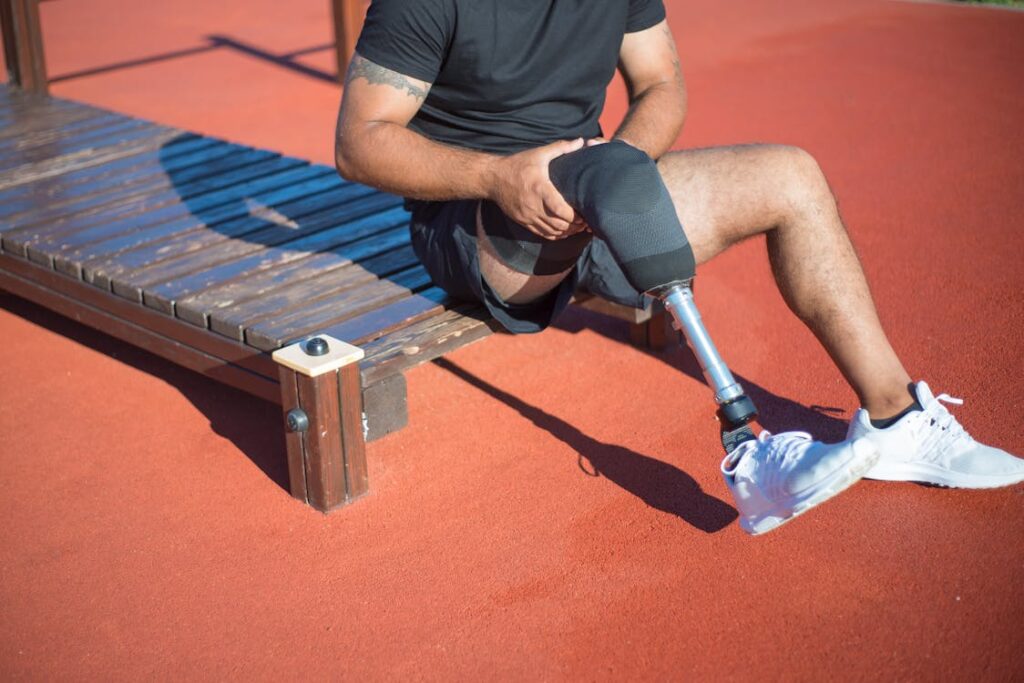
The Role of Alignment in Restoring Proprioception and Sensory Feedback
Why Your Brain Needs Good Alignment Too
Walking isn’t just a physical task—it’s also a neurological one. The brain constantly communicates with the body to maintain balance, coordinate muscles, and plan movement.
Even without a limb, the brain still expects feedback from that area. It looks for pressure, vibration, resistance, and motion to help it “feel” where the body is in space. This system is called proprioception—your body’s internal sense of position.
For prosthetic users, especially those with lower-limb amputations, proprioception doesn’t just disappear.
Instead, it starts relying on new signals—like how the socket feels against the residual limb, how the foot lands, and how the body shifts weight. All of these new signals are sent through the socket.
Here’s the key: if the socket is misaligned, those signals are unclear or confusing. The brain receives distorted information about how the body is positioned. It thinks the leg is straight when it’s not.
Or it thinks the foot has landed flat when it hasn’t. As a result, balance is harder to maintain, and movement becomes more cautious or erratic.
We often hear amputees describe this sensation as “not feeling connected” to their prosthesis. What they’re really feeling is a lack of accurate sensory feedback—caused not by the prosthetic leg itself, but by misalignment of the socket.
Alignment: The Gateway to Rebuilding Body Awareness
When we align the socket correctly, something remarkable happens. The residual limb makes even, consistent contact with the socket wall.
The foot lands properly. The pelvis stays centered. These stable, predictable signals help the brain rebuild trust in the prosthetic limb.
Over time, the user begins to feel more connected to the leg—not just mechanically, but intuitively. They know where it is without looking.
They trust it to support them when stepping down stairs or turning quickly. Their balance improves. Their reaction time gets faster. And most importantly, their fear of falling begins to fade.
This process is not just physical—it’s deeply neurological. The brain is learning to recognize and interpret new patterns. And alignment is what allows those patterns to be clean, consistent, and meaningful.
Balance and the Inner Ear: The Surprising Side Effect
Here’s something few people know: misalignment of a prosthetic socket can even influence inner ear balance.
That’s because your vestibular system (the part of your inner ear that controls balance) works together with your eyes and muscles to keep you steady.
If your body is tilted or rotated because of poor alignment, your vestibular system gets conflicting signals. Your eyes say you’re upright, but your body says you’re not.
The result can be a subtle sense of dizziness, unsteadiness, or mental fatigue. Many people chalk it up to “getting older” or “just being tired.”
But in several cases we’ve seen at Robobionics, correcting socket alignment reduced these symptoms almost overnight.
When the body is balanced and upright, the brain relaxes. It no longer needs to work overtime to correct posture or prevent falls. This frees up mental energy and improves overall confidence while moving.
Phantom Limb Sensations and Alignment
Another powerful way alignment affects the brain is through phantom limb sensations. Many amputees experience feelings in their missing limb—pressure, movement, even pain.
These sensations are part of how the brain tries to keep track of the limb that’s no longer there.
A poorly aligned socket can amplify these sensations, especially phantom pain. When pressure is uneven or unnatural, the brain misinterprets it as something going wrong in the missing limb.
But when alignment is correct, and the residual limb is supported evenly, the brain begins to “calm down.” It no longer receives signals that suggest distress or imbalance.
Several of our users have reported that once we corrected their socket alignment, their phantom pain decreased significantly.
They didn’t change medication or therapy—just the angle and position of their socket. That’s the hidden power of alignment: it speaks directly to the nervous system, not just the muscles.
Conclusion
Socket alignment is far more than a technical detail—it’s the foundation of comfort, confidence, and long-term health for every prosthetic user. When alignment is right, everything else starts to work better. Movement becomes smoother. Pain begins to fade. The brain feels connected again. From muscle balance and joint protection to emotional ease and sensory feedback, the effects are deep and lasting.
At Robobionics, we’ve seen how a small shift in socket position can create a massive shift in quality of life. That’s why we treat alignment not as a quick step, but as a core part of every fitting we do. We listen to the body. We study the movement. And we keep adjusting until it feels just right—not only on the outside, but from within.
If you’re living with pain, fatigue, or instability, know this: the answer may not be more effort. It may simply be better alignment. And that changes everything.



